COVID-19 has forced the retail industry into a state of continuous reinvention. Shifts in the landscape caused by the pandemic have necessitated a complete rethinking of retail brands’ e-commerce strategy. Many have struggled with this, while a few have found themselves ideally placed to make the most of the change.
Sales figures have fallen, growth has slowed, and online competitors have encroached upon retailers’ target markets. But the lessons from this grueling period are clear — retail businesses that will thrive in the years to come are those that have a strong digital roadmap and can adapt rapidly to change. Digital transformation has to become a key imperative for businesses that want to compete and succeed in this new market.
These are some of the challenges retailers will have to tackle over the next few years, and some ways they can overcome them.
Challenge 1: Drastic Shifts in Consumption Habits
Setting the Context
Since the pandemic, many businesses have been forced to go online almost overnight. And customers, even those who preferred to shop in-store, have now experienced the convenience of online shopping.
With so much choice available digitally now, many don’t plan to return to shopping in stores. Customer expectations have also shot up; 58 percent of customers will stop buying from a company because of poor customer experience (CX).
Convenience and immediacy are key desires. What was considered new and enticing before is now seen as table stakes, making it hard to differentiate on that basis. Customers today expect seamless omnichannel commerce, personalized experiences, a variety of payment options, free returns, and free shipping.
The customer experience bar is set extremely high. Customers are unlikely to return unless they find something unique and game-changing in the offering. Consider Pinduoduo, one of the best examples of social selling for retail giants. Pinduoduo has gamified the grocery shopping experience using team purchases and discounts, supercharging customer engagement and resulting in unprecedented usage rates.
What’s more, the customer journey doesn’t have clear start and end points anymore. Mobiles have made online shopping much more fluid, personal, and pervasive. Offering good experiences on mobile is an important need too, as customers are 62 percent less likely to return after a bad one.
[Read about embracing mobile commerce for breakneck growth]
Business Impact
Retail businesses are hard-pressed to evolve fast enough and meet customer expectations. Traditional supply chain networks lack the capabilities — technology enablement, an effective data analytics strategy, and process automation — to deliver these kinds of experiences.
All this makes customer retention harder than it has ever been before.
The Way Forward:
How to solve changing shopping habits
1. Leverage digital media to differentiate
Rather than just replicating in-store experiences online, retailers have to consider how they can use the new possibilities offered by the digital ecosystem to differentiate their products and services. Digital offers capabilities that could never be seen with a purely in-store model, such as AI-powered search, real-time inventory management, and social commerce. Executed well, any one of these could be used to create compelling, immersive experiences for customers, helping retailers to differentiate their brand.
For example, luxury department store chain Neiman Marcus is using AI-powered visual search for its “Snap. Find. Shop.” feature. Users can take a picture of products they see when they are out, take a picture of it, and upload it to Neiman Marcus’s site to get product recommendations that closely match the item. This is an example of value delivered to customers that just wouldn’t be possible without harnessing digital capabilities.

2. Make CX innovation a routine activity
Today’s customers are more interested in buying experiences rather than products. To create a lasting impact, retailers have to deeply understand their customers and offer valuable, meaningful experiences that solve real problems for them. Retailers also have to build the capabilities to offer superior value through personalized recommendations and elevated customer service. Narrowing in on a particular customer problem and offering an outstanding experience there can help set retailers apart from the competition and allow them to dominate in that area.
For example, knowing that customers needed to try on products but wouldn’t be able to physically visit stores, Ulta Beauty rapidly scaled up its GLAMlab app which lets users test makeup products before purchase. With features like Virtual Try-On, Skin Analysis, and Shade Finder, GLAMlab allows users to discover relevant products and gain confidence in their purchase decisions. Usage of the app during the pandemic went up to five times its prior level.
[Read about creating memorable e-commerce experiences with cognitive commerce]
3. Enable seamless cross-channel experiences
Delivering exceptional experiences across channels isn’t something that can be achieved through a piecemeal approach. Retailers will have to holistically re-evaluate organizational priorities and objectives, and reallocate resources accordingly.
After developing an integrated e-commerce strategy, retail brands can then make the move towards greater connectedness and flexibility by centralizing data sources, and integrating their sales, inventory, and accounting systems.
4. Prioritize retaining existing customers
Given the challenging e-commerce landscape before them today, retailers cannot afford to lose sight of existing customers’ needs and expectations from the brand. Customer retention has to be a top priority.
Setting up feedback channels, investing in improving customer service, starting education programs, as well as offering rewards, referrals, and other incentives are some of the strategies retailers can use to keep retention high.
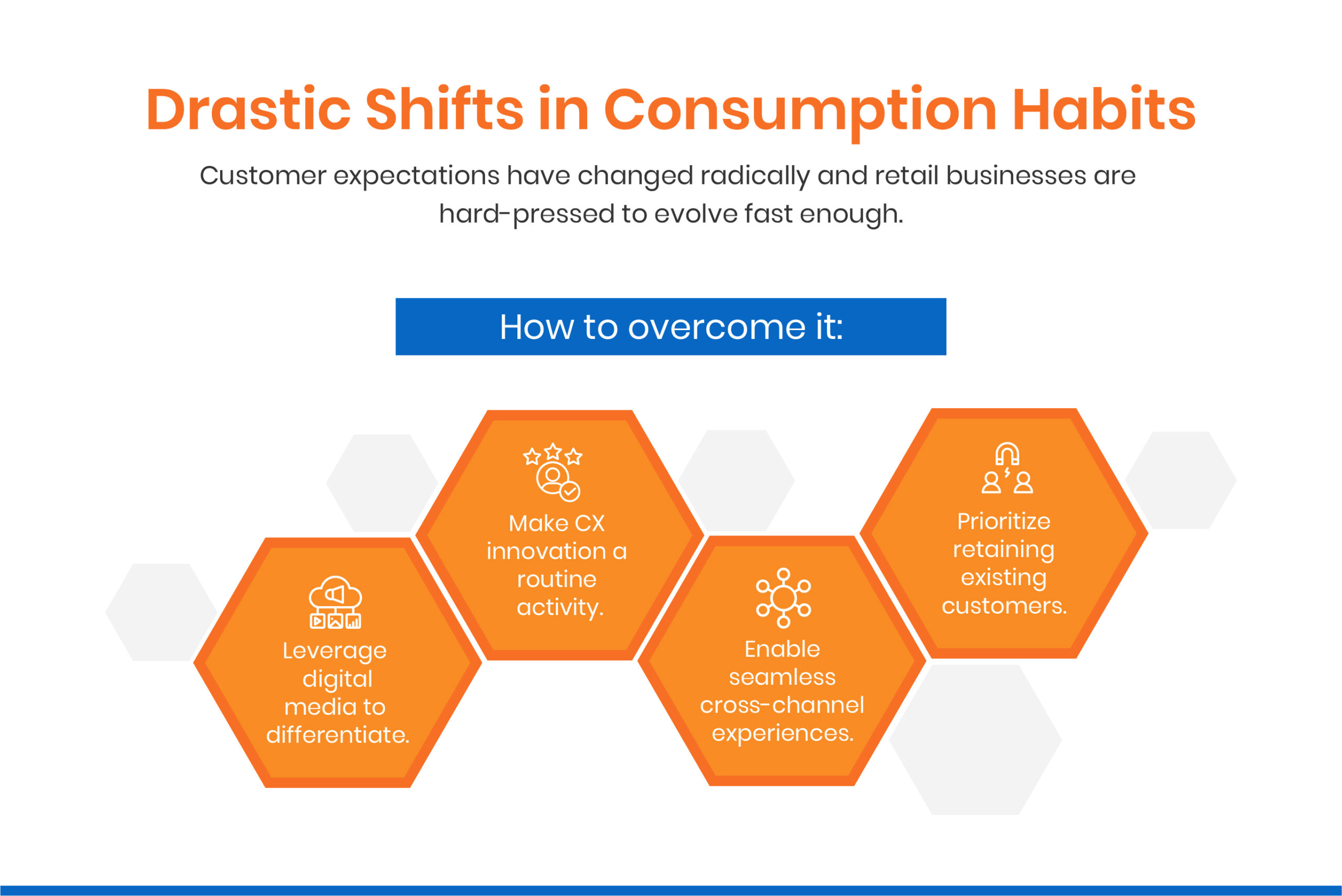
Challenge 2: Rough Playing Field for Retailers
Setting the Context
At the start of the pandemic, in 2020, worldwide retail e-commerce sales grew at a rate of 27.6 percent, crossing $4 trillion in value. Sales are expected to cross $7.3 trillion by 2025.
More and more brands have moved online during this time. In such a saturated market, retailers have to up their game to stand out from the competition.
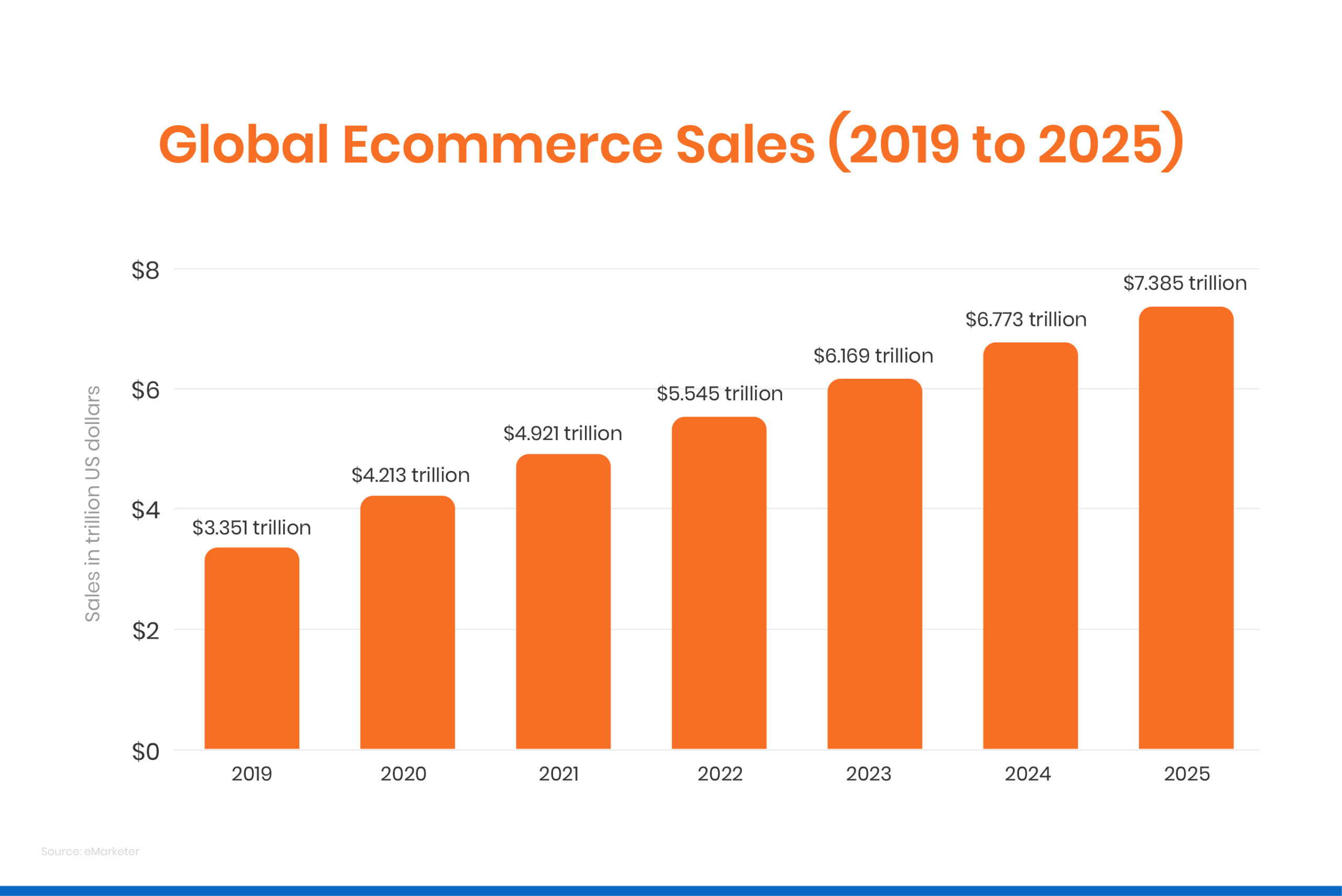
Source: eMarketer
Business Impact
Within retail, the concept of the status quo has been almost completely eroded. Retailers have to ensure constant evolution, adding new offerings and improving existing ones.
Online retail has enabled customers to compare prices and browse across multiple e-commerce platforms. Retailers who don’t want to compete on price have to come up with a very strong alternative value proposition, such as one based on quality or industry expertise.
Along with this comes higher marketing and advertising spending as retailers struggle to make themselves seen by customers. Acquisition costs have risen while the razor-thin profit margins have narrowed even further.
The Way Forward
How to stand out in e-commerce
1. Get hyper-specific about the value proposition
To compete with bigger players that dominate the industry and have access to large amounts of capital, retailers will have to get hyper-specific about the value they bring to the table. Ideally, this should be something other than price, as this would give them the opportunity to deliver fuller experiences — such as offering music classes alongside selling musical equipment. Retailers must identify the niche they want to make a play in, and then work towards owning that category. Differentiation through offering unique value such as personalized experiences or exceptional customer service is also important. Retailers who do this well can steal market share away from larger players.
As an example, furniture retailer West Elm’s Pinterest Style Finder uses neural networks to understand customers’ sense of style from scanning through their Pinterest boards. It then creates a list of home decor product recommendations that match the customer’s style. In this way, West Elm is able to offer unique value to its customers.
2. Optimize your business end-to-end
With so much competition, retailers can’t afford to let slip any opportunities to cut costs or increase margins. Whether it’s improving website experience, simplifying and automating store processes, or increasing supply chain efficiency — end-to-end optimization is essential if retailers want to gain the advantage.
[Read about 7 ways to encourage impulse buys on your e-commerce platform]
3. Use predictive analytics to uncover hidden trends
Apart from allowing retailers to offer better customer experiences, data analytics can also help them gain visibility into risks and opportunities, and make better decisions. Predictive analytics can be used to identify futuristic patterns and make the necessary adjustments across the value chain. For example, retailers can forecast revenues per department, identify what new products customers will be interested in, make improvements in supply chain efficiency, or implement better pricing strategies.
[Read about High-Profit, High-Growth E-commerce: 5 Ways to Increase Your E-commerce Business’ Profitability]
4. Be willing to test new channels and business models
Instead of limiting efforts in one arena, retailers should tap into multiple channels. Short experiments with new business models can reveal previously undiscovered opportunities. They can also indicate flaws in the e-commerce strategy for retail brands. Being nimble and quickly exiting underperforming channels while dynamically ramping up investment in others can help retailers come up with the most profitable channel mix for their brand.
5. Consider partnering with other businesses
Partnerships with other retailers can help retailers leverage their joint capabilities and win together where any single retailer couldn’t win alone. Such partnerships can help eliminate a single point of failure and increase efficiencies.
Together, retailers can sell on a large enterprise-level marketplace platform, reducing their overheads. They can also draw upon each other’s capabilities, such as warehousing space or delivery services.
Actively pursuing M&A strategies can be another way to quickly scale up capabilities.
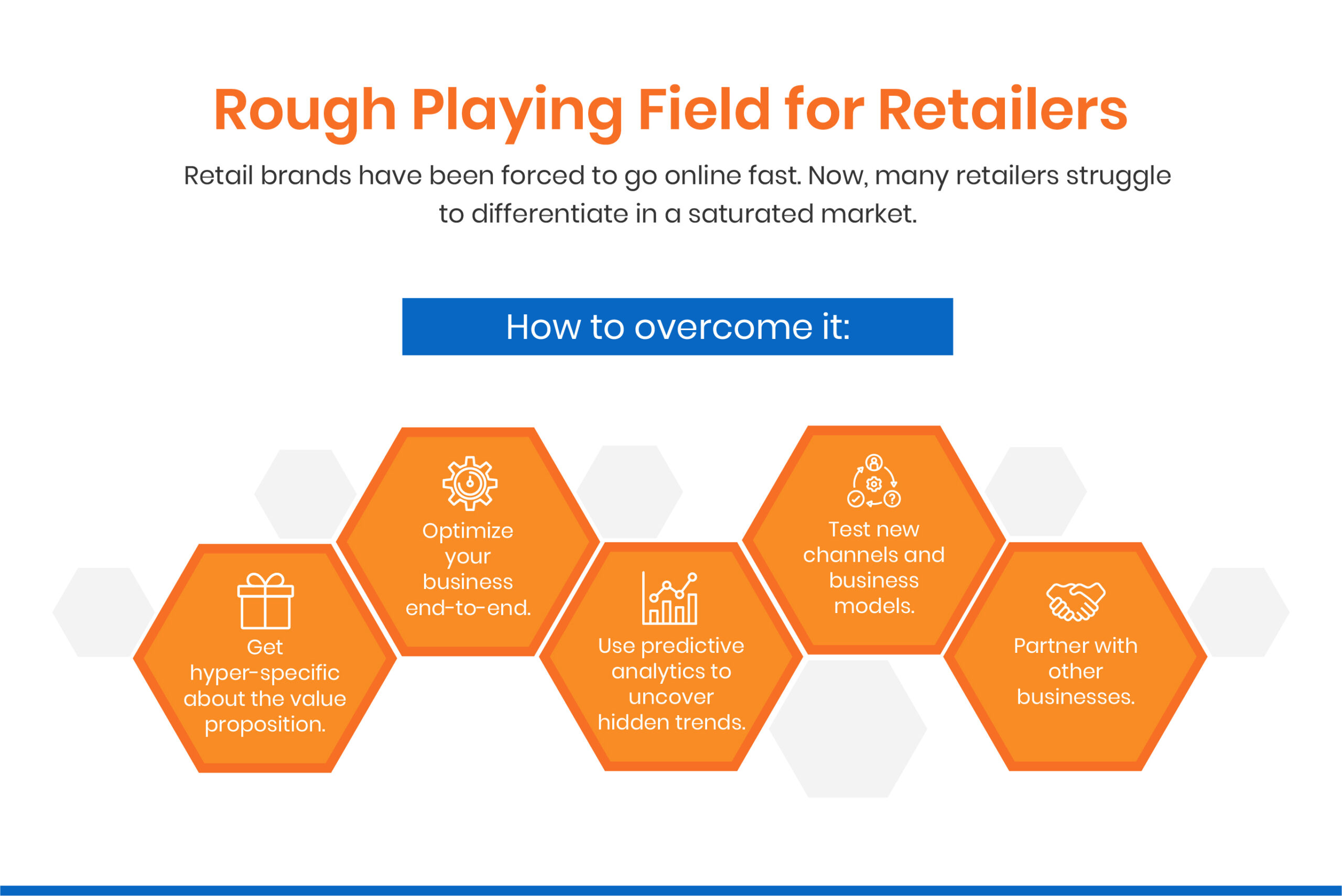
Challenge 3: Uncertainty Continues to Impact Supply Chain Efficiency
Setting the Context
While businesses have made rapid strides to set up online operations in the wake of the pandemic, not many have been able to effectively manage the complexity of retail operations.
Businesses that already had a progressive approach towards online channels have thrived, while others — even well-established brands which didn’t have a strong digital proposition or had under-utilized online channels — have been left in a state of crisis or forced to close their doors.
Business Impact
A study by the United Nations Conference on Trade and Development (UNCTAD) of e-commerce businesses across 23 countries found that 58 percent of businesses selling their products or services online have reported a drop in monthly revenue. Two-thirds of businesses reported higher operational costs, and 44 percent reported a reduction in their workforce.
Social distancing has dramatically altered the way staff works together in any physical location. Entire countries shutting down has created manufacturing losses and product availability challenges. Unprecedented shipping and tracking difficulties have forced sellers to delay deliveries by months, adding to costs and making it harder to manage inventory.
Customers’ discretionary spending patterns have changed, with many losing work opportunities or taking pay cuts. While customers have become more focused on getting value for money, most still expect perks like fast, free shipping.
The Way Forward
How to fix e-commerce supply chain challenges
1. Supply chain restructuring is a necessity
The right approach could help turn fulfillment into a competitive advantage. Retailers can do this in several ways.
One approach could be to adopt omnichannel fulfillment strategies like third-party logistics (3PL), buy-online-pick-up-in-store (BOPIS), curbside pickup, etc. Many have done this, with Shopify reporting that nearly 100,000 brands began offering curbside pickup during the pandemic.

Another approach could be for retailers to reconsider how they can best use existing infrastructure. It may turn out to be more cost-efficient to use physical resources in a novel way e.g. turning existing retail stores into temporary mini-fulfillment centers.
Artificial intelligence (AI) and machine learning (ML) capabilities can be implemented to automate inventory management and forecasting, anticipating demand spikes, preventing stockouts, and creating new efficiencies.
Clothing retailer H&M is doing just this, using AI to analyze store receipts and returned items at each of its stores. This lets them know which items are most popular, so that they can be restocked as needed, and also which items aren’t selling well so that the store can prevent overstocking. In this way, each store’s inventory can be kept aligned with customers’ preferences.
Finally, retailers can also leverage on-demand logistics through partnerships with other organizations that have the warehousing or delivery capacities they lack. In this way, they can create symbiotic relationships that benefit both parties.
To succeed, retailers have to be ready to make the best use of their infrastructure and resources in an agile, flexible way, building resiliency into their operations.
2. Optimize the returns process to reduce the logistics burden
It’s estimated that almost a third of products purchased online are returned. This presents retailers with a fulfillment challenge of staggering proportions.
Understanding why customers return products is the first step. Gathering this information through on-page surveys and other means will be vital. Then, developing product descriptions that offer sufficient detail, improving product images and adding video content, implementing dynamic sizing, or using AI/ML to power virtual try-on apps are some strategies that can help retailers reduce the rate of returns.
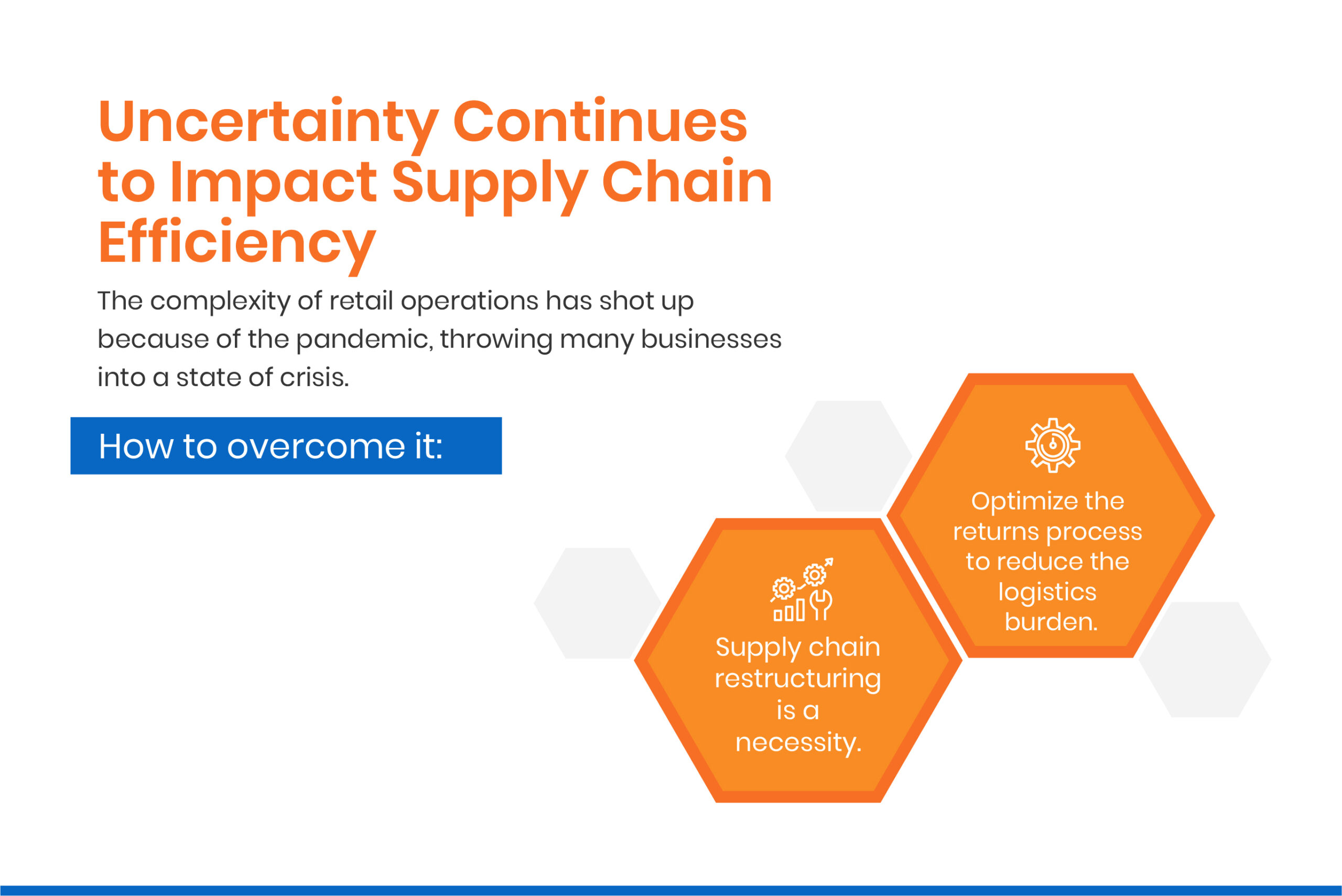
Challenge 4: Sourcing the Right Technology for Growth
Setting the Context
In 2019, 13.6 percent of sales were made online. In 2021, this figure is expected to grow to 19.5 percent, registering a 45.8 percent increase over two years.
Technology is one of the key drivers for growth in the present retail landscape, but most retailers aren’t yet able to effectively leverage its capabilities.
Business Impact
Data is the most valuable tool in the hands of retailers, but many don’t know where to start with data management and analytics. With customers’ financial data in their hands, data security is another concern. Investing in secure servers and safe checkout processes is a critical step.
E-commerce operations pose a significant technical challenge in terms of their complexity. The best e-commerce platforms facilitate seamless collaboration between many different parties including customers, sellers, logistics staff, suppliers, etc. It can be a massive challenge to build a system that simplifies all this complexity and enables smooth business operations. But this also presents a unique opportunity for radical new applications of technology that can create untapped business efficiencies.
The Way Forward
How to find the right technologies for your business
1. Digital transformation (DX) is an absolute imperative
Retailers need to invest in DX initiatives to gain the ability to quickly pivot from offline to online channels and back again when needed.
The pandemic has made this clear by widening the divide between industry leaders and ‘other’ players. Businesses that were already ahead of the curve before the pandemic have seen significant gains while others have suffered tremendous losses. Technology has a leading role to play in increasing retail business viability and profitability.
Home furnishings retailer Williams-Sonoma is a good example. With its digital transformation initiatives underway since well before 2017, the pandemic allowed the brand to dominate in its space. In the second quarter of 2020, the retailer reported 30 percent growth in its sales and net revenues.
Retailers that want to catch up with industry leaders will have to take big leaps in terms of imagination, operational transformation, and technology implementation. The first step for many in this journey is finding the right technology partner for their e-commerce business.
This also means that in-house IT departments cannot be relegated to a supporting role anymore. Instead, technology needs must be kept front and center and tied in holistically to support business goals and initiatives across departments.
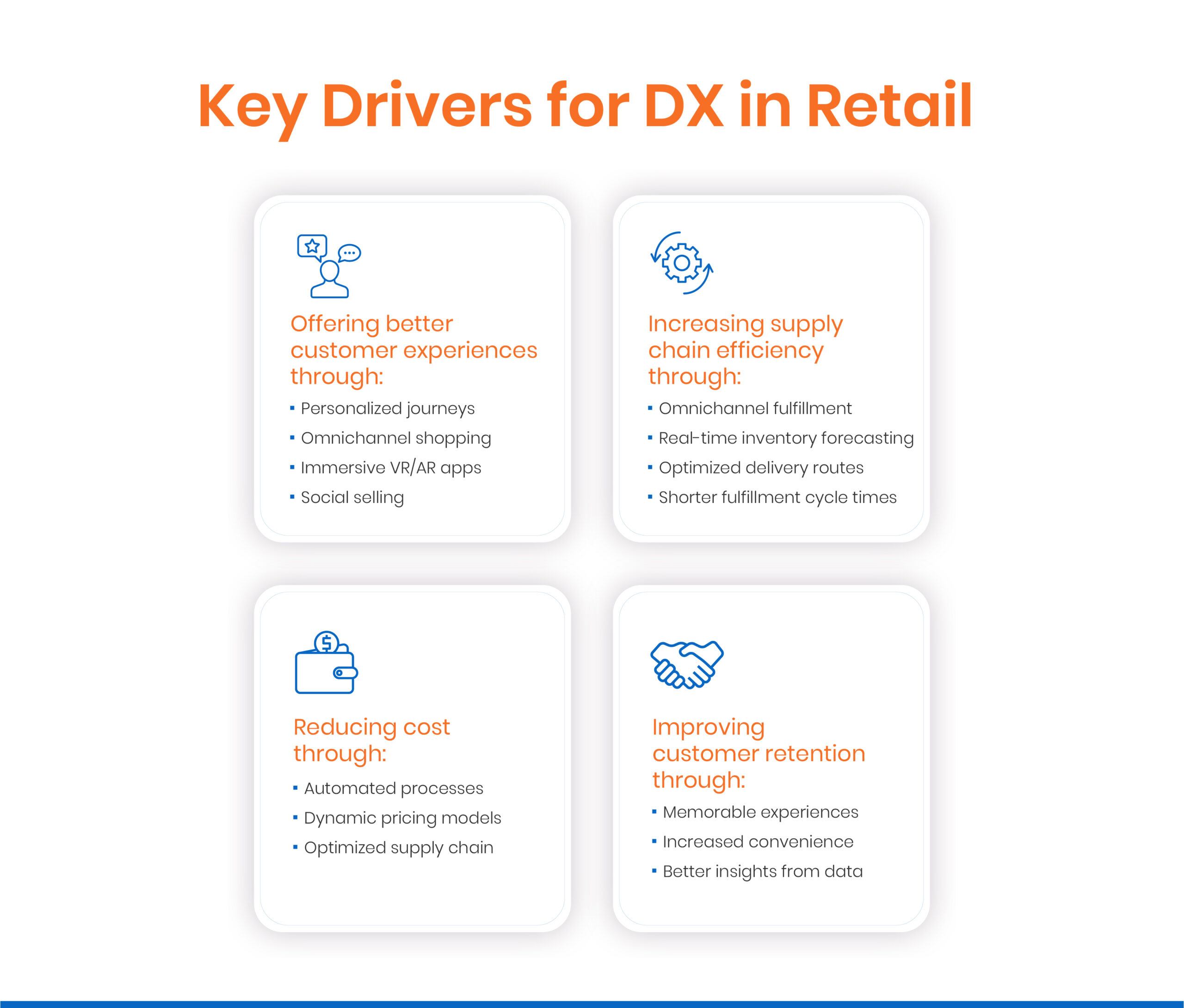
2. Prioritize developing a unified view of data
Being able to harness the data available is crucial to success in retail.
To achieve this, retailers have to begin with building a single view of data to be used for all data queries and reports. This helps gives decision-makers access to the right data at the right time, making it easier to implement cross-channel user journeys and centralize workflow management.
Without this unified view, retailers will face challenges further down the line with product availability, inconsistent or inadequate communication, or time lost due to tasks being repeated.
3. Consider headless architecture for greater flexibility
By decoupling the frontend presentation layer from the backend e-commerce payer, retailers can gain added flexibility in terms of the technologies that can be used on the frontend. This allows them to create dynamic, engaging experiences for customers on the frontend using a variety of technologies like React and Angular while still effectively managing complex e-commerce functionality on the backend.
To bolster its mobile-first strategy, footwear retailer Nike adopted a headless architecture, using React SPA and Node.js backend for frontend (BFF). This has helped the brand make more sales on mobile and increase its market share. Target is another major brand that opted to go headless to offer better omnichannel experiences to its customers.
Retailers using headless commerce can quickly customize and replicate the solution across different geographies and brands, speeding up their time to market and gaining the ability to deliver omnichannel experiences at scale.
4. Stay lean and agile
Finally, retailers must remember that there’s no such thing as a perfect strategy. It’s more effective to favor constant small-scale experimentation to find what works best for the brand rather than waste time and miss the opportunity altogether. Making quick decisions and opting to fail fast offers retailers a far better chance of success. Testing and piloting new technologies across the value chain will help retailers identify new use cases or areas that need improvement and get ahead in the race for customer attention.
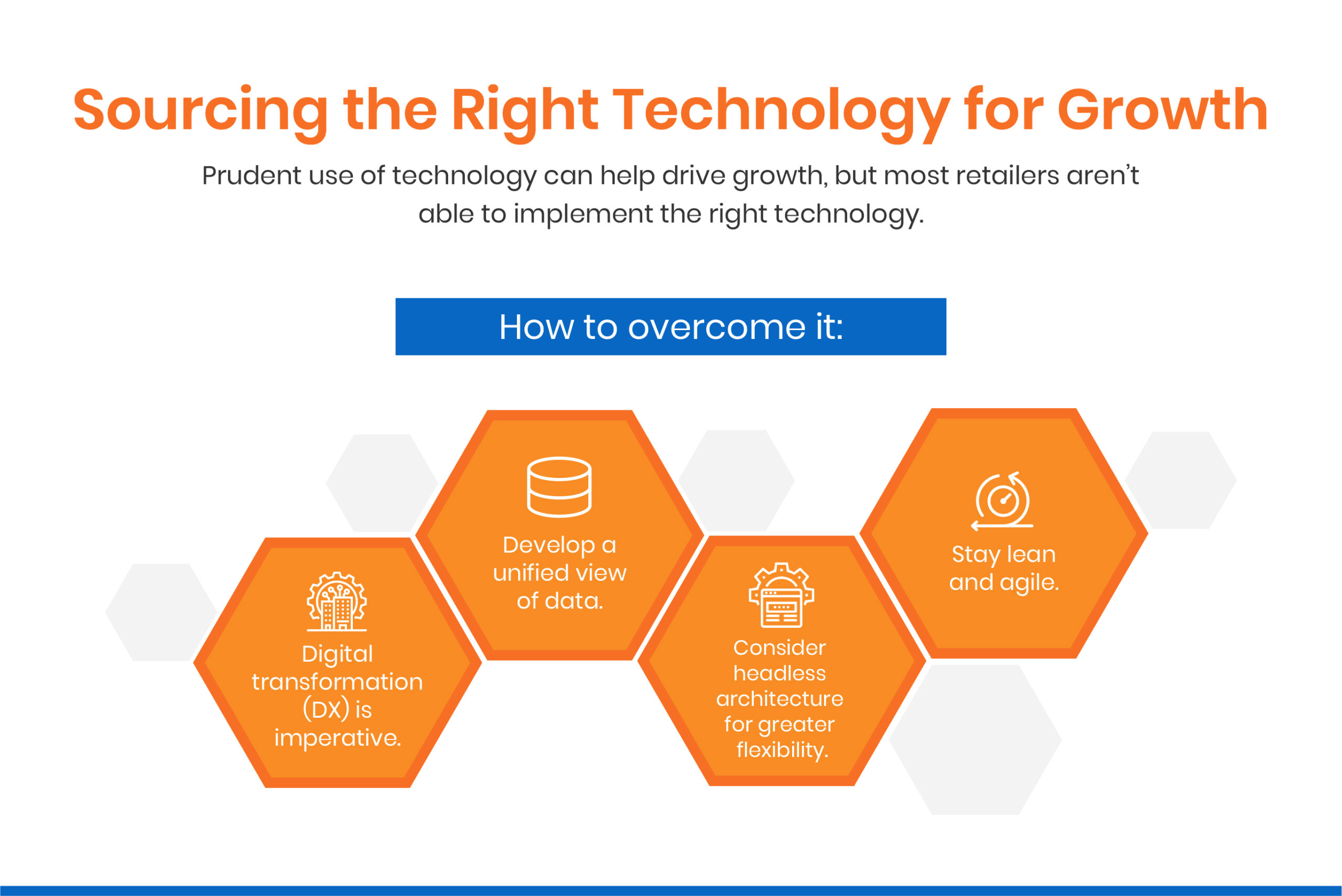
Conclusion
If they are to succeed amid the present cost pressures and uncertainty, retailers have to act decisively and make bold decisions about the future. Rapid implementation of new capabilities and using existing resources in the most efficient way possible are both critical for retailers.
For many, this will mean revisiting their entire business model and undertaking massive transformation initiatives, supported by the right technology partner for their e-commerce business. But those who are able to do this successfully will unlock opportunities and gain strategic advantages that could potentially buoy them up for decades to come.












